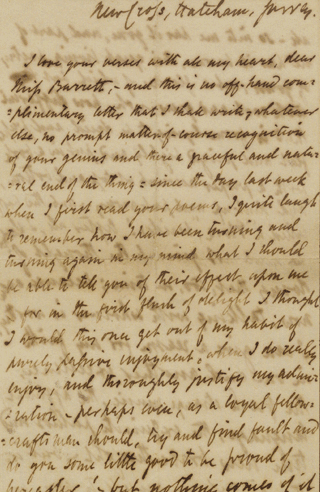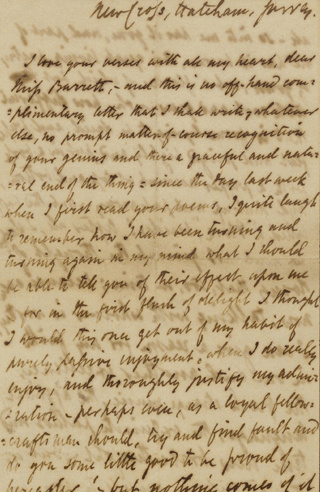
Baylor University
By Mallory Hisler
Reporter
Love went digital this Valentine’s Day.
Baylor and Wellesley College of Massachusetts have joined together in an effort to preserve the massive correspondence between popular historical poets Robert and Elizabeth Barrett Browning, while also making them available to all.
On Tuesday, Baylor’s digital collections released a search engine that provides digital images of the Browning’s 573 handwritten love letters that are located in Wellesley’s Margaret Clapp Library.
“The collaborative task provides unprecedented free online access to these celebrated letters for scholars and romantics alike — and may inspire readers to opt for pen and paper over text messages and emails this Valentine’s Day,” according to a Baylor press release.
College Archivist Ian Graham of Wellesley said working with Baylor for the project was an easy decision.
“Baylor already had resources for people looking for information… and it is a large repository for information about the Brownings,” Graham said.
Both Wellesley and Baylor are known for their extensive collections regarding the poetic couple, and both expressed a desire to let others see the original correspondence while still keeping those documents safe from decomposition that comes from age and handling.
“Scholars from this day forward are able to access them and do research with them, and they don’t have to travel to Wellesley,” Graham said.
Darryl Stuhr, manager of digitization projects of the electronic library at Baylor, echoed Graham.
“The goal is to get all of the Browning correspondence online, that way we can give people access and reduce handling,” Stuhr said. “People can do their research and scholarly work without actually handling the documents.”
Mariana Oller, associate curator of special collections at Wellesley, expressed joy at the idea of others being able to see the letters she has handled personally.
“We truly believe that these letters belong to the world. They must be available for everyone to read in the text and handwriting of the authors,” Oller said.
“Not only scholars, but everyone interested in accessing them can look at the letters.”
The online letters have been transcribed and are full-text searchable. The transcribed versions can be viewed alongside the images of the actual letters, Stuhr said.
To search for something in a letter, the user can go to the electronic library’s digital collection, select the Browning letters and type in a key word.
Pattie Orr, Baylor’s vice president for Information Technology and dean of libraries, has already tried out the search engine.
“Surprisingly, the Brownings never used the word ‘Valentine’, but they did use ‘heart’ and ‘love’ many times,” she laughed.
Though nearly 600 of the Browning’s love letters were published, much other correspondence has been preserved and will be digitized with the project.
“Our main goal is to be able to digitize all of the Browning correspondence over in the Armstrong Browning Library to give greater access to the collection,” Stuhr said.
The Armstrong Browning Library owns around 3,000 letters to and from the Brownings. “Our goal is to get them all out by the end of the summer,” Stuhr said. “This is a nice big chunk and a good test of what we’ve got.”
Orr, who came to Baylor from Wellesley, said she is excited about Tuesday’s release.
“It’s been a long partnership through many years,” she said. “Because Wellesley has these courtship letters and some other items as well, we began to think, ‘Wouldn’t it be great if we could work on this together and have them all together for everyone?’”
Orr said the university is inviting anyone with Browning letters to have them digitized and added to Baylor’s online collection.
The goal for both colleges is to preserve the magic of the handwritten letters for many years to come, which is something that Oller is excited about.
“Even though you are online, you can see each stroke and see the texture of the paper,” she said. “I hope that people do get inspired by looking at the originals, and that they seek those materials from our history and learn from them directly. Nothing is more precious.”
The partnership between the schools has produced something that they both hope will impact the Browning research field for a long time.
“This has opened the door that doesn’t have to be closed. It’s international scholarship that is open to the public and at no charge,” Graham said. “This is a wonderful partnership that we’ve struck here between two colleges with the biggest repositories on the Brownings.”
But Orr, along with the others involved in the project, stressed that was not simply for scholars.
“Whether you’re an 8th grader just learning about sonnets or a senior-level professor that’s an expert on it, this is something that everyone can experience and enjoy,” Orr said.






